6 Best Cellular Trail Cameras in 2025 – Reviews & Buyer’s Guide
Last Updated on
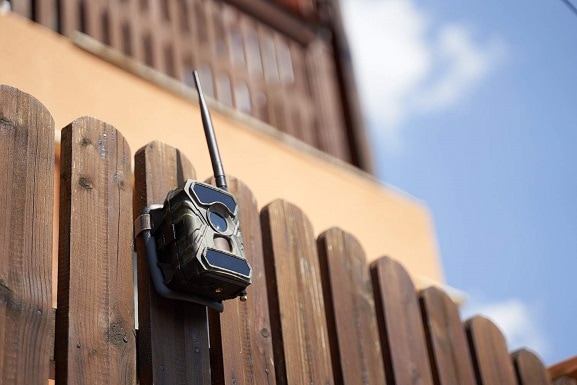
Wireless and cellular trail cameras are a newer addition to the trail camera family. With so many different models and new features, it can be challenging to choose a model that makes you happy.
We have reviewed many different models and simplified the task of choosing your next trail camera. We picked six different models that we think are worth looking at, and we’ll explain what we like and don’t like about each one.
We’ve also included a buyer’s guide that we hope will help you learn what to look for when choosing a cellular trail camera so you can have an easier time should you do more shopping around.
Keep reading for our detailed reviews of each wireless trail camera, where we compare image clarity, megapixels, data usage, and durability to help you make an educated purchase.
Let’s look at the models we’ve chosen to review.

A Quick Look at Our Favorites (2025 Update)
| Image | Product | Details | ||
|---|---|---|---|---|
| Best Overall |
 |
Bigfoot 3G |
|
CHECK PRICE |
| Best Value |
 |
Moultrie XA7000i |
|
CHECK PRICE |
| Premium Choice |
 |
CREATIVE XP |
|
CHECK PRICE |
 |
SPARTAN |
|
CHECK PRICE | |
 |
Covert Blackhawk |
|
CHECK PRICE |
The 6 Best Cellular Trail Cameras:
1. Bigfoot 3G Cellular Trail Camera – Best Overall
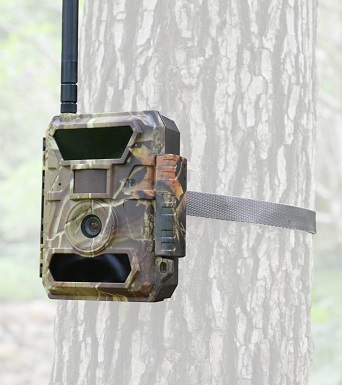
The Bigfoot 3G is our choice for best overall cellular trail camera. It has all the essential features at a reasonable price. This camera produced clear images with a wide field of view. You can adjust the trigger sensitivity and time-lapse speeds. It features an infrared flash that we felt illuminated objects nicely, allowing for exceptional detail even with the reduced field of view at night. A free app lets you control most of the camera’s functions right from your phone, and to save on data use, you can set limits on the number and quality of pictures.
On the downside, the Bigfoot 3G does seem to drain a lot of battery life when using the app to control settings, and if the signal is weak when it takes a picture, it won’t send it to your phone.
- Clear images
- Wide field of view
- Limit data use
- Adjustable trigger sensitivity
- App uses up battery power
- Can lose images
2. Moultrie XA7000i Wireless Trail Camera – Best Value
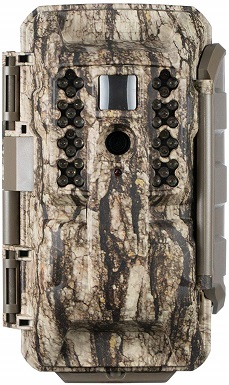
The Moultrie Mobile XA7000i Cellular Trail Camera is our choice for the best value, and we believe that after you look over what this camera has to offer, you will agree it’s the best wireless and cellular trail camera for the money. This camera runs on 4G technology and delivers clear 20-megapixel images and high definition 1080p video. It has an invisible flash and can detect movement up to 80 feet away.
Our only complaint is the extreme sensitivity of the unit can cause it to send a lot of blank pictures until you have it set up correctly. These blank pictures can use up quite a bit of data while you’re fine-tuning the focus, and it will continue to send blank images from time to time. Wasted data can get expensive, and that’s the reason we didn’t rank it best overall.
- 20-megapixel image
- 4G technology
- Detects movement up to 80 feet
- Extreme sensitivity can waste data
3. CREATIVEXP Cellular Trail Camera – Premium Choice
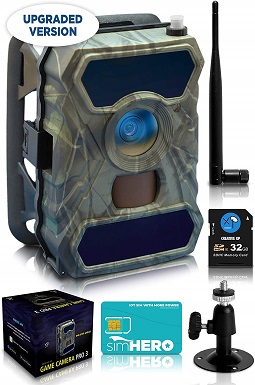
The CREATIVEXP035 is our premium choice. This model is for the person who needs a high-quality camera and isn’t afraid to spend the extra cash to get it. We loved the extra-wide 110-degree lens. It helps create clear 12-megapixel images and 1080p HD video. You can configure the camera to take fewer megapixel images to save space and data if you need to.
It is an expensive camera, and high-quality images can use a lot of data and battery life. The reason it didn’t rank higher on our list is that this model was one of the most difficult to set up of all the models on this list, and it can sometimes revert to default settings without warning.
- High-quality images
- Wide-angle lens
- Highly configurable
- Expensive
- Difficult set-up
4. SPARTAN Cellular Trail Cameras
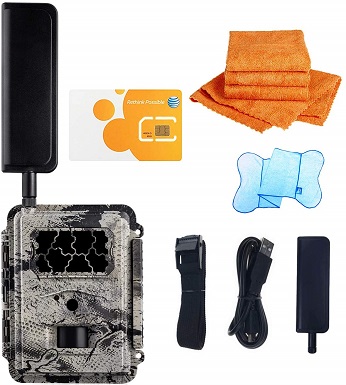
The SPARTAN GC-A4Gb HD GoCam is a small but durable rail camera that produced clear images and videos. It will send the pictures to your phone or store them on an SD card. We liked the ability to set different duty periods, which allowed for different time-lapse rates at different times of the day. You’ll need 12 AA-sized batteries power the device, but it didn’t seem to use much power during our reviews. There are also upgrades sold separately, like the ability to use solar energy.
We didn’t like the SIM card because it is married to the device, and you cannot change to another, and it requires you to purchase data plans through their company instead of one of your choosing. This model also has a large field of view, but an animal needs to be quite close to set it off and get a picture.
- Clear Image
- low power consumption
- Upgrades
- Marries SIM card
- The animal needs to be very close to set off the camera
5. Covert Blackhawk Realtree Trail Camera

The Covert Blackhawk LTE Verizon Realtree Trail Camera is a compact wireless trail camera with some excellent features. It takes 14-megapixel pictures or 1280×720 HD-video with sound. It features a no-glow infrared flash that uses 60 LEDs and can illuminate to a distance of 100 feet. The still images contain helpful timestamp information and stored on an SD card or transmitted to your phone. It gives you burst and time-lapse modes and provides real-time wind and weather information.
We felt that the battery drain was strong on this model, especially when trying to use the video recording. Moving animals are blurry, and we have concerns about Blackhawk’s durability.
- 14-megapixel images
- 60-LED flash
- Real-time wind and weather
- Battery drain
- Blurry images on moving animals
- Durability
6. SPYPOINT Link Micro Trail Camera
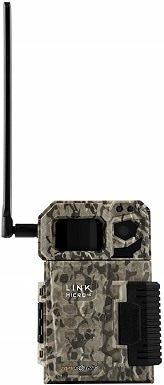
The SPYPOINT Link Micro Camera is the final model that we want to present to you. It’s not in the same league as our first three picks, but it may still have some features that interest you. The Skypoint is the smallest camera on our list, powered by eight AA batteries. It features a four LED low glow flash illuminating to a distance of 80 feet.
The Skypoint is useful in situations where you need a small camera, but the 10-megapixel images are low quality compared to other cameras on this list. We also had a hard time obtaining and maintaining a strong signal.
- Tiny size
- 10-megapixel images
- Weak signal receiver

Buyer’s Guide – Picking the Best Cellular Trail Camera
Let’s have a look at some of the different things you might look for when picking the best cellular trail camera.
On a budget? Check out these posts:
Power options
The power source is one of the first considerations you will need to make concerning your trail camera, and there are three standard options, solar, battery, and plug-in.
Plug-In Power
Cameras that use plug-in power are good for around the home to protect from burglary and unwanted animals in your yard or garbage.
Battery Power
Batteries are an excellent choice and can last a long time under the right conditions. You can find trail cameras that use all types of batteries, from standard AA to lithium-ion. You will want to check your camera’s documentation to see how long batteries last before you purchase as traveling to the camera location to change the batteries can taint the area with your scent.
Solar Power
Many cameras feature solar cells, and they are a perfect choice if you are placing the camera in an area that receives plenty of light. A camera that runs on solar power alone will never require you to travel to its location, but it won’t work at night and often won’t work in grey-sky conditions either. Some models use the solar cells to help keep a battery charged and are a good balance of both worlds.

Images
Let’s look at some of the things we need to look for regarding images and image quality.
Image Quality
The image quality is a vital aspect of the camera. One of the best ways to judge image quality is by looking at the number of megapixels. The more megapixels a trail camera has, the better. Look for a camera that has a minimum of 10 megapixels.
Picture Taking Modes
Many trail cameras offer different modes of picture taking for different purposes.
Burst mode
Burst mode is when the camera takes several pictures very quickly once triggered. This mode is perfect for getting a high-quality picture of the object that gets close to your camera.
Time Lapse mode
Time-lapse mode is when the camera takes a picture every so often at a predetermined interval regardless of what is in view. This mode is perfect for learning the behavior of animals near the camera. Time-lapse will help you determine the entrance and exit path an animal takes as well as how much time it spends in the area.
Time and Date Stamps
Time and date stamps on your images will help you keep track of when thing s happen and helps look for behavioral patterns in the animals you capture on film.
Video
Some cameras can offer video recording capability and can record video in a burst or in a time-lapse manner. Video is a nice feature, but it can significantly affect battery life, and the larger video files will impact your data plan.
Video Resolution
If your trail camera does offer video, you will want to look into the resolution of the footage it provides. A higher resolution will mean a better picture, but it will also mean more storage space, data used, and power consumed.
Audio
Another feature to look for if your trail camera offers video is audio to accompany the video. Like resolution, audio can enhance your experience but will also quickly drain your resources.
Flash
We’ve all seen how flash works on a standard camera, but a trail camera offers us a few other options.
White Glow Flash
A white glow flash is the standard flash we all know. It produces a bright white light that illuminates our subject. This type of flash is not very useful on the trail as it is likely to scare any animals.
Low Glow Flash
The low glow flash is a type of flash that uses a dim red light to capture black and white photos at night. While the image quality is not excellent, it usually won’t scare the wildlife.
No Glow Flash
The no-glow flash produces high-quality black and white night photos by using a flash outside the visible spectrum, eliminating any chance of accidentally scaring wildlife. This type of light is often considered Night Vision.
Flash Range
The flash range is vital to getting a good picture at night. The brighter a flash is, the more area it will illuminate, and the more detail an image will have.
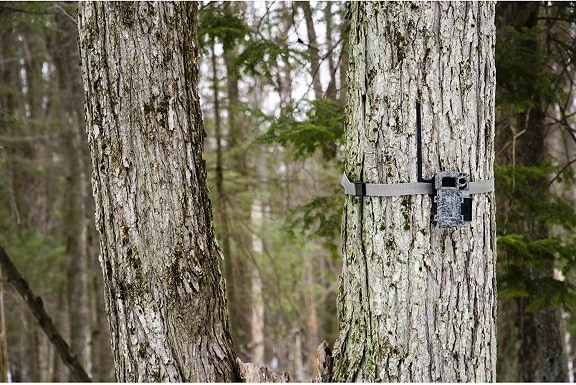
Storage SD Cards
While most of the trail cameras we will be looking at send the images directly to your phone, eliminating the need for a storage medium, some cameras will still store their data to an SD card. If your camera uses an SD card, be sure to use one as much storage space as you can find to reduce the number of times you need to visit the camera to retrieve the card.

Other Important Factors to Consider
Here are a few more things to consider before making a final decision about your trail camera.
Trigger Time
The trigger time is how fast your camera reacts to an object entering its view. The faster the trigger time, the less chance you will miss something. Some animals like birds are speedy and will require a short trigger time.
Reset time
The reset time is how long a camera takes to reset and take another picture once it has taken a picture. Another way to look at it is how long the camera gives an animal to move out of view before it snaps another picture.
Detection Range
The detection range is how sensitive the trail camera is to movement. It tells us how close to the camera an animal needs to be before it snaps a picture. Sometimes this is adjustable to give an animal time to move into view before snapping the picture.
Field of View
The field of view determines how much area is seen by the camera. Cameras with a large field of view will take pictures of a large area.
Data Plan
Every one of the trail cameras on this list requires a data plan. Multiple cameras will require a data plan for each camera. Many service providers have special plans for these kinds of devices that are less costly per month, and many trail camera brands include help with obtaining service.
Tips for using a Wireless or Cellular Trail Camera
- Visit it as infrequently as possible
- Take the time to set up your cameras trigger time correctly
- Save data by reducing megapixels during off-peak times
- Keep the firmware updated
- Make sure the camera is secure
- Be patient

Conclusion:
We hope that after reading our reviews and our buyer’s guide, you feel better equipped to make an educated decision about purchasing a trail camera. We stand by our choice for best overall the Bigfoot 3G Trail Camera features a crystal-clear image, a wide field of view, and intense infrared flash lighting. Our best value, the Moultrie Mobile XA7000i Cellular Trail Camera, features detailed 20-megapixel images and speedy 4G technology at bargain prices.
If you enjoyed this cellular trail camera guide and it helped you make a decision you are happy with, please share this article on Facebook and Twitter.
See also: our in-depth comparison of Browning Trail Cameras
About the Author Robert Sparks
Robert’s obsession with all things optical started early in life, when his optician father would bring home prototypes for Robert to play with. Nowadays, Robert is dedicated to helping others find the right optics for their needs. His hobbies include astronomy, astrophysics, and model building. Originally from Newark, NJ, he resides in Santa Fe, New Mexico, where the nighttime skies are filled with glittering stars.
Related Articles:
How to Clean a Refractor Telescope: Step-by-Step Guide
How to Clean a Telescope Eyepiece: Step-by-Step Guide
How to Clean a Rifle Scope: 8 Expert Tips
Monocular vs Telescope: Differences Explained (With Pictures)
What Is a Monocular Used For? 8 Common Functions
How to Clean a Telescope Mirror: 8 Expert Tips
Brightfield vs Phase Contrast Microscopy: The Differences Explained
SkyCamHD Drone Review: Pros, Cons, FAQ, & Verdict



